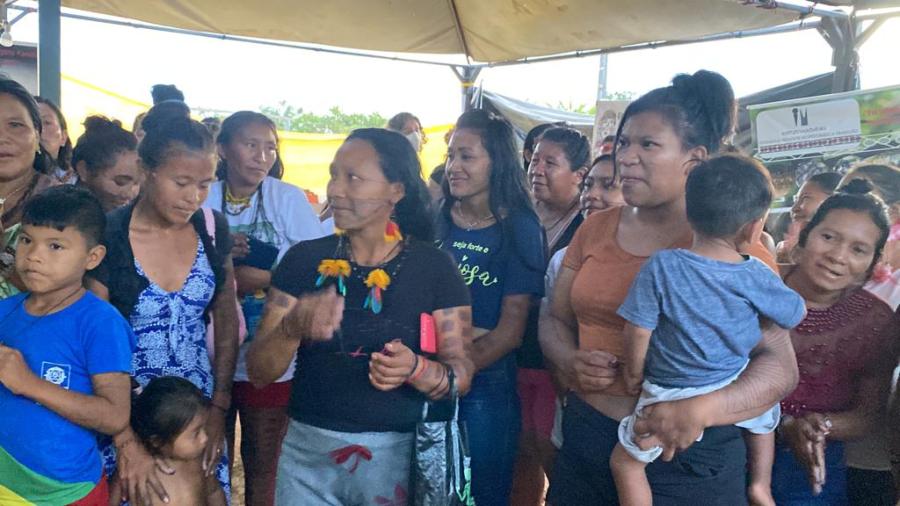Shavante women of central Brazil, 1958-1982
Twenty-five years ago the only way to reach the Shavante Indians near the Rio das Mortes in central Brazil was by plane or boat. By boat the journey took weeks, through territory inhabited only by nomadic Indians. Luckily, my husband, baby son and I went by plane, but even so it was days before we were finally deposited at a roughly cleared landing strip near a Shavante village. The dilapidated two-engine plane took off, leaving us in a sea of naked and semi-naked people whose language we could barely understand.
Our first visit to the village was quite ceremonious. The chief's sons solemnly walked us - one in the front and one behind - to their father's hut, which was occupied by the chief, his daughters, their husbands and their children. We were led to a tall beehive-shaped hut which we stooped to enter through a tunnel-like doorway. Once our eyes had become accustomed to the darkness we identified the chief, lying on his mat to the right of the entry, using his hardwood club as a headrest. He was naked, but his wife, who sat next to him, was dressed in a shapeless shift made from cheap cloth donated by people who felt that nakedness was sinful.
We sat down, presents were given and a halting conversation ensued. Suddenly the women carried our little son into the recesses of the hut. I could hear them giggling as they gathered around him, and went over to see what was going on. Their curiosity had been too much for them, so they had taken off his diaper to see what sex he was. The good humor continued as I dressed him again, while the men ignored us and carried on their solemn conversation about such trivia as the weather, what they saw and said on the last hunting trip and whether there were enough feathers to make new arrows.
The Shavante built "our" hut next door to the chief's. Men cut the trees for it and lashed them into the beehive frame. Women brought in the palm leaves and put them over the frame to provide the thatch cover. Once we were installed in the village, I sat like the other women outside the doorway of my hut in the evenings, looking at the sweeping semi-circle of dwellings that comprised the village and listening to the men making speeches in the center of it. The men discussed everything from the day's gossip to matters of life and death, while the women talked among themselves and occasionally shouted comments and objections to the men in the middle.
In the mornings, often before sunrise, I would be woken by one of my neighbors who whispered that we had to be off hunting for berries and especially for roots. We would file off with our boat-shaped baskets slung from our foreheads and resting on our backs. Several of the baskets weren't empty, but contained sleeping babies who would soon have to share their cribs with the day's produce, for the women always found something to eat.
As we trudged through open savannah or dense undergrowth we would occasionally get glimpses of parties of men out after boar, or lone hunters setting out for days at a time in quest of deer. There would be huge excitement in the village when the men came staggering in under loads of meat; but most returned empty-handed. Then it was the "women's food" that kept everybody going.
On other days I would take my little son and walk a few miles to one of the clearings where Shavante planted their traditional crops of corn, beans and squash. They were only just beginning to plant manioc, the staple of their Brazilian neighbors, and they did so with some reluctance, for they feared it required too much care and would interfere with the nomadic lifestyle which they prized so highly. Men cut and burned the trees and undergrowth, leaving the women to plant, weed and harvest the crops in the rough clearings. Men would often accompany their wives to the gardens, ostensibly to help them but also because they were places where a couple could make love in relative privacy.
Shavante neither sought nor enjoyed much privacy in their villages and looked on chronic loners with suspicion. Loneliness was a characteristic they associated with malevolent spirits. Human beings were by contrast gregarious. Yet men and women, though they did not avoid each other, spent little time in each other's company. Almost every day the men's groups, age-sets composed of individuals of roughly the same age, danced around the village or busied themselves with the elaborate ritual ceremonies. The women might help the men get painted but they themselves neither painted nor took part in the ceremonies. We sat by the huts at the periphery and witnessed the essentially male goings-on in the center.
In the 1950s Shavante technology was very simple. The most used utensil - apart from the shotgun we brought - was the digging stick, which served as a club to break an enemy's head, a tool for knocking down bee's nests on the savannah, a hoe for clearing and planting, a head rest for sleeping, and a host of other things. Women wove beautiful baskets for which the Shavante are famous and also manufactured the characteristic necklaces from the seeds of a bush, baked hard, pierced one by one and then laboriously strung together.
We went back to visit the Shavante in 1982, twenty-three years after that first meeting, to see how they were faring now that Brazil had caught up with them. I was particularly curious about how the women's lives had changed. This time we could drive, although we left the tarmac and jolted for days over dirt roads which finally degenerated into tracks. When we were thoroughly lost, literally stalking the Shavante in the countryside over which we had once gathered roots and berries and hunted with them, we came at last to the crest of a bluff and saw far below the familiar semicircle of beehive huts.
An hour later we were again among the people who had surrounded us on the airstrip so many years ago. This time there were speeches of welcome to which my husband replied in rusty Shavante. Our hosts appreciated the courtesy but it was no longer strictly necessary. The villagers now spoke Portuguese and had grown worldly wise. Gone were the days when a blond baby might cause a stir among the women, or when the men's council discussed matters relating to hunting and feuding. Now they cross-questioned us about the Malvinas/Falkland Islands war which they had heard about on their transistor radios. During the bitter struggles to retain control of their lands they had become knowledgeable about national and local politics and Shavante leaders had become famous in Brasilia for their tough and domineering manner of dealing with the authorities.
National elections took place while we were with them and I found myself driving all night to ferry a dozen young Shavante men to the polls. They had been instructed by their chief to vote as soon as the polls opened and then get out of town before the usual election day drinking and fighting started. One of them expertly drove the vehicle back over the difficult trails. When the results came we learned that Mario Juruna, a Shavante running in the cosmopolitan state of Rio de Janeiro, had become the first Indian ever elected to the Federal Chamber of Deputies.
The lives of the Shavante have been transformed in many ways during the last 25 years. Their involvement in a government-sponsored rice cultivation project is very different than their old hunting and gathering subsistence strategies. The men's groups no longer dance around the village every day; the groups of younger men are usually away at the rice fields, where Shavante can be seen driving tractors and bringing in the harvests which have made this part of the country the rice bowl of the Brazilian interior. The men still love hunting and are constantly on the lockout for game, but it has become more of a pastime than a subsistence activity. One elder persuaded me to drive him to visit the Brazilian cowboy who was minding his cattle. On the way he suddenly ordered me to stop the car. He steadied his revolver with a hand on my shoulder and shot a deer from the car window.
Men now wear black jeans or soccer shorts and store-bought red sports shirts. But women still wear shapeless dresses even though they now have sewing machines. Clothes, like body painting - which is still done - appear to be ways for men, not women, to decorate their bodies.
While some Shavante villages do have water piped to communal faucets and a few even have electricity to light half a dozen lamp posts in the village for a couple of hours every evening, the changes over the past twenty years have not lightened the women's labor. The improved water supply has only slightly lessened the additional burden of washing and caring for clothes which has fallen entirely on the women. The women still gather wood and cook the food over open fires as they have since time immemorial. They still tend the subsistence crops, once the men have done the heavy work of clearing the gardens. In addition they are now intensively engaged in animal husbandry. Every woman is expected to raise chickens and "good managers" rear guinea fowl, pigs and even ducks. Yet as the Shavante become increasingly involved in the cash economy, proceeds from women's labor is controlled by men.
Where there are schools for the Shavante, both sexes attend them, but neither the Shavante nor the missionaries or government agencies which run the schools expect women to keep up with men. It is the men who will travel as soon as they are old enough. Some boys have even attended Brazilian schools in faraway towns and a few are at the universities in Sao Paulo, Rio and Brasília. It is the men who learn how to deal with Brazil and the Brazilians, and who increasingly are acquiring the skills which enable them to enter the Brazilian labor market. Women continue to perform their traditional tasks, but their work has become more onerous. They are now expected to do more with less help from men and little technological assistance.
The most dramatic effect of modernization has been the downgrading of women's roles in Shavante society. Traditionally, Shavante men and women lived largely separate lives and performed separate tasks, but the collaboration and interdependence between them was clearly understood and was at the heart of Shavante values and their daily lives. Today, Shavante men are sophisticated, and they tend to see the women less as the other pillar of Shavante life and more as a backward category of people relegated to do endless chores.
Article copyright Cultural Survival, Inc.



